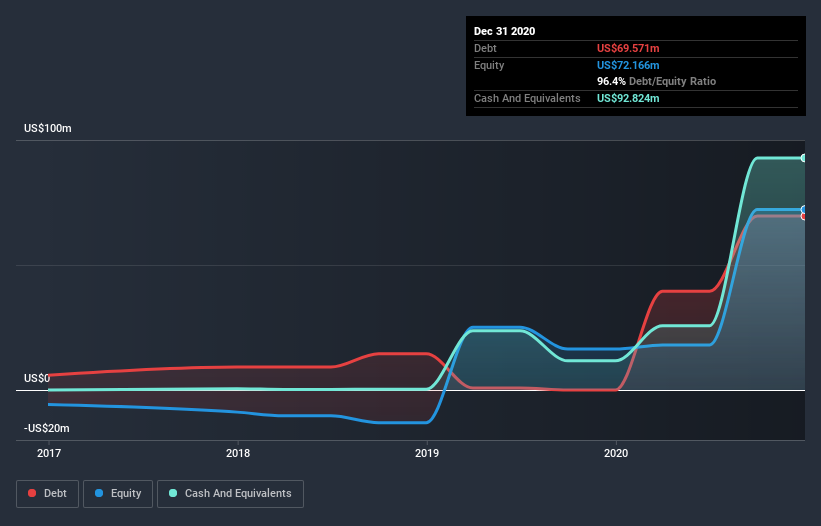Here's Why Splitit Payments (ASX:SPT) Can Manage Its Debt Despite Losing Money
David Iben put it well when he said, 'Volatility is not a risk we care about. What we care about is avoiding the permanent loss of capital.' So it might be obvious that you need to consider debt, when you think about how risky any given stock is, because too much debt can sink a company. We note that Splitit Payments Ltd (ASX:SPT) does have debt on its balance sheet. But the real question is whether this debt is making the company risky.
When Is Debt Dangerous?
Debt and other liabilities become risky for a business when it cannot easily fulfill those obligations, either with free cash flow or by raising capital at an attractive price. In the worst case scenario, a company can go bankrupt if it cannot pay its creditors. However, a more usual (but still expensive) situation is where a company must dilute shareholders at a cheap share price simply to get debt under control. Having said that, the most common situation is where a company manages its debt reasonably well - and to its own advantage. The first thing to do when considering how much debt a business uses is to look at its cash and debt together.
View our latest analysis for Splitit Payments
What Is Splitit Payments's Debt?
As you can see below, at the end of December 2020, Splitit Payments had US$69.4m of debt, up from none a year ago. Click the image for more detail. But it also has US$92.8m in cash to offset that, meaning it has US$23.4m net cash.
How Healthy Is Splitit Payments' Balance Sheet?
According to the last reported balance sheet, Splitit Payments had liabilities of US$38.0m due within 12 months, and liabilities of US$37.4m due beyond 12 months. Offsetting this, it had US$92.8m in cash and US$51.8m in receivables that were due within 12 months. So it can boast US$69.2m more liquid assets than total liabilities.
It's good to see that Splitit Payments has plenty of liquidity on its balance sheet, suggesting conservative management of liabilities. Because it has plenty of assets, it is unlikely to have trouble with its lenders. Simply put, the fact that Splitit Payments has more cash than debt is arguably a good indication that it can manage its debt safely. When analysing debt levels, the balance sheet is the obvious place to start. But it is future earnings, more than anything, that will determine Splitit Payments's ability to maintain a healthy balance sheet going forward. So if you want to see what the professionals think, you might find this free report on analyst profit forecasts to be interesting.
In the last year Splitit Payments wasn't profitable at an EBIT level, but managed to grow its revenue by 307%, to US$6.7m. That's virtually the hole-in-one of revenue growth!
So How Risky Is Splitit Payments?
By their very nature companies that are losing money are more risky than those with a long history of profitability. And the fact is that over the last twelve months Splitit Payments lost money at the earnings before interest and tax (EBIT) line. Indeed, in that time it burnt through US$67m of cash and made a loss of US$25m. With only US$23.4m on the balance sheet, it would appear that its going to need to raise capital again soon. The good news for shareholders is that Splitit Payments has dazzling revenue growth, so there's a very good chance it can boost its free cash flow in the years to come. High growth pre-profit companies may well be risky, but they can also offer great rewards. The balance sheet is clearly the area to focus on when you are analysing debt. However, not all investment risk resides within the balance sheet - far from it. To that end, you should learn about the 5 warning signs we've spotted with Splitit Payments (including 1 which is concerning) .
Of course, if you're the type of investor who prefers buying stocks without the burden of debt, then don't hesitate to discover our exclusive list of net cash growth stocks, today.
This article by Simply Wall St is general in nature. It does not constitute a recommendation to buy or sell any stock, and does not take account of your objectives, or your financial situation. We aim to bring you long-term focused analysis driven by fundamental data. Note that our analysis may not factor in the latest price-sensitive company announcements or qualitative material. Simply Wall St has no position in any stocks mentioned.
Have feedback on this article? Concerned about the content? Get in touch with us directly. Alternatively, email editorial-team (at) simplywallst.com.

